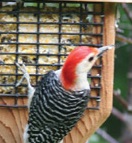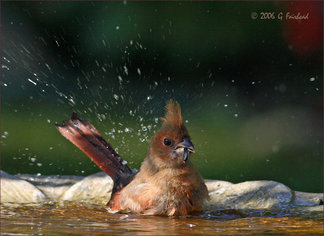Blog - General
Summer Bird Feeding
For which ever purpose you use the home made nectar, remember to change it approximately every other day to prevent fermentation and mold. A bacterial growth could prove to be fatal. Commercial nectars are available and need only be change every 4 to 6 days.. Remember in Nebraska be ready for hummingbirds migrating through by mid-August
One food that seems an unlikely summer choice is suet. Birds eat roughly 30% more animal protein during the summer, in fact woodpeckers consume more suet from March to August than they do all winter long. Raw suets are messy and smell foul when they turn rancid in warm weather. There are commercial no melt suets available that are very attractive. Here is a home made no melt suet recipe you may find useful; over low heat, melt one cup lard and one cup crunchy peanut butter. Stir in two cups quick cook oats, two cups yellow corn meal, one cup white flour and one third cup of sugar. For a real treat add a cup of chopped nuts. Pour this mixture into plastic containers and store in your freezer.
The most important component of any summer, as well as winter, feeding station is water. From a simple sauce pan filled with water to the traditional concrete pedestal bird bath, to an elaborate avian pool with a waterfall or fountain, the birds will be delighted. Birds find the sound of moving water attractive if not irresistible, and can detect such sound from great distances. A dripper added to a simple bird bath will create that sound as well as provide motion in the water that is very appealing and may attract many more visitors than you can imagine. A well maintained water feature will attract more species of birds to your yard both in summer and winter than any kind of food. Warblers, vireos, flycatchers and thrushes, as well as the usual corps of feeder birds drink and bathe regularly when a fresh source of water is made available. Place the birdbath in the open so predators cannot stalk and surprise preoccupied birds. Nearby branches of trees provide a good spot for preening once they have finished, and keeping the bath in a shaded area will help to retard algae growth.
traditional concrete pedestal bird bath, to an elaborate avian pool with a waterfall or fountain, the birds will be delighted. Birds find the sound of moving water attractive if not irresistible, and can detect such sound from great distances. A dripper added to a simple bird bath will create that sound as well as provide motion in the water that is very appealing and may attract many more visitors than you can imagine. A well maintained water feature will attract more species of birds to your yard both in summer and winter than any kind of food. Warblers, vireos, flycatchers and thrushes, as well as the usual corps of feeder birds drink and bathe regularly when a fresh source of water is made available. Place the birdbath in the open so predators cannot stalk and surprise preoccupied birds. Nearby branches of trees provide a good spot for preening once they have finished, and keeping the bath in a shaded area will help to retard algae growth.
A well stocked summer feeding station does not tempt birds away from what they normally eat. It is merely an alternative that some species take advantage of and others ignore. It lessens competition for what foods are available, and more time can be devoted to nesting when less time is spent having to forage for food. You will be highly rewarded as the cardinals, chickadees, finches, woodpeckers and others bring their fledglings to the feeders for the first time.
A good summer feeding program is not to unlike that set up for winter feeding such as elevated feeders for safflower seed and sunflower seed. These can be hopper, open port tube or platform feeders. A thistle tube feeder with fresh thistle is always attractive. White millet on the ground feeder will be swarmed by native sparrows. And do not forget to offer suet. You will be pleasantly surprised. But the summer brings the added advantage of providing live food, fresh fruits and of course, hummingbird feeders. Combined with a consistent fresh source of water you’ll find summer backyard bird feeding a unique and enjoyable experience. It may provide the most colorful diverse show of the year.
